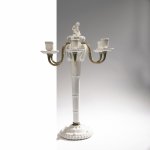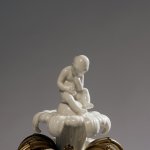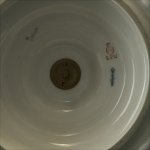Lot: 499
Adolph Amberg
Candelabrum from the 'Wedding Parade', 1908
Naked, eating little girl sitting on a blossom on the top. H. 61 cm, D. 43 cm. Made by: KPM Berlin, 1912. Porcelain, white, glazed, gilded bronze. Signed: Maker's mark (blue, under glaze), date letter M, O, 1H (embossed).
Hammer Price: 3,800 €
17. November 2021 at 3:00 PM CEST
Literature:
Bröhan Museum Berlin, Berliner Porzellan vom Jugendstil zum Funktionalismus, Berlin o. J., No. 186; Treskow, Die Jugendstil-Porzellane der KPM Berlin, Munich 1971, No. 188 (archive photo).
The wedding parade of Adolph Amberg
After the announcement of the engagement of Crown Prince Wilhelm of Prussia and Cecilie of Mecklenburg-Schwerin, the Prussian Association of Cities decided on 7 November 1904 to give the imperial couple a joint wedding present. It was agreed to commission a silver centerpiece like they had done for Emperor Wilhelm II in 1881. At the end of 1904, the trained silversmith and sculptor Adolph Amberg, among others, presented his design for a centerpiece. However, it was rejected by the court right away. Theodor Schmuz-Baudiss, artistic director of KPM Berlin, wrote a little later in an unspecified "private note": "Her Majesty the Empress (Auguste Viktoria, FY) thought these figures to be too naked" (quoted from Treskow, Die Jugendstil-Porzellane der KPM Berlin, Munich 1971, p. 130, note 410). Even though the German imperial family rejected Amberg's design, his contemporaries nevertheless recognized the quality and innovation of the different, true-to-life and expressive figures from different parts of the world and so the KPM Berlin bought the models three years later and gradually produced them, initially in the years 1908 to 1910. When the entire wedding procession was presented for the first time at the Great Berlin Art Exhibition in 1911, it was already an international success (Treskow, p. 109). We are pleased to be able to offer you the complete centerpiece, consisting of twenty figures, two six-flamed candelabra and a jardinière, which the collector has collected with great zeal over decades, sometimes in several executions.
Read our Terms & Conditions.






